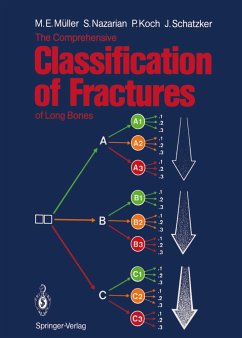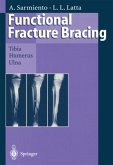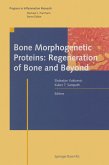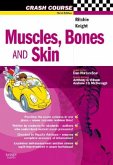Maurice E. Müller, Serge Nazarian, Peter Koch, Joseph Schatzker
The Comprehensive Classification of Fractures of Long Bones
Mitwirkender: Koch, Peter; Nazarian, Serge; Müller, Maurice E.
Maurice E. Müller, Serge Nazarian, Peter Koch, Joseph Schatzker
The Comprehensive Classification of Fractures of Long Bones
Mitwirkender: Koch, Peter; Nazarian, Serge; Müller, Maurice E.
- Broschiertes Buch
- Merkliste
- Auf die Merkliste
- Bewerten Bewerten
- Teilen
- Produkt teilen
- Produkterinnerung
- Produkterinnerung
The history of the origin and development of the new Classification of Fractures was described in the preface to the French edition. The history of the acceptance of this new concept dates back to 1986, when the Swiss Association for the Study of the Problems of Internal Fixation (AO) accepted the new Classification of Fractures. In the same year, the Trustees of the AO/ASIF Foundation, at their annual meeting in Montreux, adopted the new AO Classification as the basis for fracture classification to be used in the planned third edition of the AO/ASIF Manual. In August 1987, the French edition…mehr
Andere Kunden interessierten sich auch für
![Functional Fracture Bracing Functional Fracture Bracing]() Augusto SarmientoFunctional Fracture Bracing226,99 €
Augusto SarmientoFunctional Fracture Bracing226,99 €![Clinical Documentation Specialist - The Comprehensive Guide Clinical Documentation Specialist - The Comprehensive Guide]() Viruti ShivanClinical Documentation Specialist - The Comprehensive Guide24,99 €
Viruti ShivanClinical Documentation Specialist - The Comprehensive Guide24,99 €![Clinical Documentation Specialist - The Comprehensive Guide Clinical Documentation Specialist - The Comprehensive Guide]() Viruti ShivanClinical Documentation Specialist - The Comprehensive Guide23,99 €
Viruti ShivanClinical Documentation Specialist - The Comprehensive Guide23,99 €![Bone Morphogenetic Proteins: Regeneration of Bone and Beyond Bone Morphogenetic Proteins: Regeneration of Bone and Beyond]() Slobodan Vukicevic / Kuber T. Sampath (eds.)Bone Morphogenetic Proteins: Regeneration of Bone and Beyond77,99 €
Slobodan Vukicevic / Kuber T. Sampath (eds.)Bone Morphogenetic Proteins: Regeneration of Bone and Beyond77,99 €![Muscles, Bones and Skin Muscles, Bones and Skin]() Judith RitchieMuscles, Bones and Skin22,99 €
Judith RitchieMuscles, Bones and Skin22,99 €![Osteologia Nova, or Some New Observations of the Bones and the Parts Belonging to Them, With the Manner of Their Accretion and Nutrition, Communicated Osteologia Nova, or Some New Observations of the Bones and the Parts Belonging to Them, With the Manner of Their Accretion and Nutrition, Communicated]() Osteologia Nova, or Some New Observations of the Bones and the Parts Belonging to Them, With the Manner of Their Accretion and Nutrition, Communicated32,99 €
Osteologia Nova, or Some New Observations of the Bones and the Parts Belonging to Them, With the Manner of Their Accretion and Nutrition, Communicated32,99 €![Thieme Test Prep for the Usmle(r) Clinical Anatomy Q&A Thieme Test Prep for the Usmle(r) Clinical Anatomy Q&A]() Mark H. HankinThieme Test Prep for the Usmle(r) Clinical Anatomy Q&A36,99 €
Mark H. HankinThieme Test Prep for the Usmle(r) Clinical Anatomy Q&A36,99 €-
-
-
The history of the origin and development of the new Classification of Fractures was described in the preface to the French edition. The history of the acceptance of this new concept dates back to 1986, when the Swiss Association for the Study of the Problems of Internal Fixation (AO) accepted the new Classification of Fractures. In the same year, the Trustees of the AO/ASIF Foundation, at their annual meeting in Montreux, adopted the new AO Classification as the basis for fracture classification to be used in the planned third edition of the AO/ASIF Manual. In August 1987, the French edition of "The Comprehensive Classification of Fractures of Long Bones" made its first appearance, coincident with the Congress of the International Society of Orthopaedic Surgery (SICOn in Munich. This precipitated a great deal of interest in the subject. This interest persisted, so that in February of 1988 the President of SICOT, Sir Dennis Paterson, formed a "Presidential Commission for Documentation and Evaluation" with Maurice E. Muller as Chairman.
Produktdetails
- Produktdetails
- Verlag: Springer, Berlin
- Seitenzahl: 216
- Erscheinungstermin: 13. August 1990
- Englisch
- Abmessung: 270mm x 193mm x 12mm
- Gewicht: 714g
- ISBN-13: 9783540181651
- ISBN-10: 3540181652
- Artikelnr.: 26706068
- Herstellerkennzeichnung
- Springer-Verlag GmbH
- Tiergartenstr. 17
- 69121 Heidelberg
- ProductSafety@springernature.com
- Verlag: Springer, Berlin
- Seitenzahl: 216
- Erscheinungstermin: 13. August 1990
- Englisch
- Abmessung: 270mm x 193mm x 12mm
- Gewicht: 714g
- ISBN-13: 9783540181651
- ISBN-10: 3540181652
- Artikelnr.: 26706068
- Herstellerkennzeichnung
- Springer-Verlag GmbH
- Tiergartenstr. 17
- 69121 Heidelberg
- ProductSafety@springernature.com
General Section.- 1. Principles of the Classification of Fractures.- 1.1 Morphological Characterization of a Fracture.- 1.2 The Location.- 1.3 Alpha-numeric Coding of the Diagnosis of a Fracture.- 2. The Long Bones, General Comments.- 2.1 Coding of the Long Bones.- 2.2 The Determination of the Segments of the Long Bones and of the Center of a Fracture.- 2.3 The Classification of Diaphyseal Fractures.- 2.3.1 The Diaphyseal Fracture Types.- 2.3.2 The Groups of the Diaphyseal Fractures of the Humerus, Femur, and Tibia/Fibula.- 2.3.3 The Groups of the Diaphyseal Fractures of the Radius/Ulna.- 2.3.4 A Comparative Analysis of 2700 Surgically Treated Diaphyseal Fractures.- 2.3.5 The Subgroups .1, .2, and .3 of the Diaphyseal Groups Al, A21, A3, and B1, B2, B3.- 2.3.6 The Subgroups .1, .2, and .3 of the Diaphyseal Groups Cl, C2, C3.- 2.3.7 The Qualifications for the Diaphyseal Subgroups.- 2.4 The Classification of Fractures of the Proximal and Distal Segments.- 2.4.1 The Fracture Types of Segments 13- and 33-, 21- and 41-, 23- and 43-.- 2.4.2 The Fracture Types for the Segments 11- and 31-.- 2.4.3 The Fracture Types for the Segment 44-.- 2.4.4 The Groups Al, A2, A3 of the Segments 13-, 21- and 23-, 33-, 41- and 43-.- 2.4.5 The Groups B1, B2, B3 of the Segments 13-, 21-, 23-, 33-, 41-, and 43-.- 2.4.6 The Groups Cl, C2, C3 of the Segments 13-, 21- and 23-, 33-, 41- and 43-.- 2.4.7 The Nine Groups Al to C3 of the Proximal Humerus = Segment 11-.- 2.4.8 The Nine Groups Al to C3 of the Proximal Femur = Segment 31-.- 2.4.9 The Avulsion Fractures of the Proximal and Distal Segments.- Special Section, Long Bones.- 1. Humerus = 1.- 1.1 Humerus, Proximal Segment = 11-.- 1.1.1 The Types.- 1.1.2 The Groups.- 1.1.3 The Subgroups and Their Qualifications.- 1.2 Humerus, Diaphyseal Segment = 12-.- 1.2.1 The Types.- 1.2.2 The Groups.- 1.2.3 The Subgroups and Their Qualifications.- 1.3 Humerus, Distal Segment = 13-.- 1.3.1 The Types.- 1.3.2 The Groups.- 1.3.3 The Subgroups and Their Qualifications.- 1.3.4 Comments.- 2. Radius/Ulna = 2.- 2.1 Radius/Ulna, Proximal Segment = 21-.- 2.1.1 The Types.- 2.1.2 The Groups.- 2.1.3 The Subgroups and Their Qualifications.- 2.2 Radius/Ulna, Diaphyseal Segment = 22-.- 2.2.1 The Types.- 2.2.2 The Groups.- 2.2.3 The Subgroups and Their Qualifications.- 2.3 Radius/Ulna, Distal Segment = 23-.- 2.3.1 The Types.- 2.3.2 The Groups.- 2.3.3 The Subgroups and Their Qualifications.- 3. Femur = 3.- 3.1 Femur, Proximal Segment = 31-.- 3.1.1 The Types.- 3.1.2 The Groups.- 3.1.3 The Subgroups and Their Qualifications.- 3.1.4 Comments.- 3.2 Femur, Diaphyseal Segment = 32-.- 3.2.1 The Types.- 3.2.2 The Groups.- 3.2.3 The Subgroups and Their Qualifications.- 3.3 Femur, Distal Segment = 33-.- 3.3.1 The Types.- 3.3.2 The Groups.- 3.3.3 The Subgroups and Their Qualifications.- 4. Tibia/Fibula = 4.- 4.1 Tibia/Fibula, Proximal Segment = 41-.- 4.1.1 The Types.- 4.1.2 The Groups.- 4.1.3 The Subgroups and Their Qualifications.- 4.2 Tibia/Fibula, Diaphyseal Segment = 42-.- 4.2.1 The Types.- 4.2.2 The Groups.- 4.2.3 The Subgroups and Their Qualifications.- 4.2.4 Comments.- 4.3 Tibia/Fibula, Distal Segment = 43-.- 4.3.1 The Types.- 4.3.2 The Groups.- 4.3.3 The Subgroups and Their Qualifications.- 4.4 Tibia/Fibula, Malleolar Segment = 44-.- 4.4.1 The Types.- 4.4.2 The Groups.- 4.4.3 The Subgroups and Their Qualifications.- 4.4.4 Comments about Malleolar Fractures.- Glossary = Dictionary.
General Section.- 1. Principles of the Classification of Fractures.- 1.1 Morphological Characterization of a Fracture.- 1.2 The Location.- 1.3 Alpha-numeric Coding of the Diagnosis of a Fracture.- 2. The Long Bones, General Comments.- 2.1 Coding of the Long Bones.- 2.2 The Determination of the Segments of the Long Bones and of the Center of a Fracture.- 2.3 The Classification of Diaphyseal Fractures.- 2.3.1 The Diaphyseal Fracture Types.- 2.3.2 The Groups of the Diaphyseal Fractures of the Humerus, Femur, and Tibia/Fibula.- 2.3.3 The Groups of the Diaphyseal Fractures of the Radius/Ulna.- 2.3.4 A Comparative Analysis of 2700 Surgically Treated Diaphyseal Fractures.- 2.3.5 The Subgroups .1, .2, and .3 of the Diaphyseal Groups Al, A21, A3, and B1, B2, B3.- 2.3.6 The Subgroups .1, .2, and .3 of the Diaphyseal Groups Cl, C2, C3.- 2.3.7 The Qualifications for the Diaphyseal Subgroups.- 2.4 The Classification of Fractures of the Proximal and Distal Segments.- 2.4.1 The Fracture Types of Segments 13- and 33-, 21- and 41-, 23- and 43-.- 2.4.2 The Fracture Types for the Segments 11- and 31-.- 2.4.3 The Fracture Types for the Segment 44-.- 2.4.4 The Groups Al, A2, A3 of the Segments 13-, 21- and 23-, 33-, 41- and 43-.- 2.4.5 The Groups B1, B2, B3 of the Segments 13-, 21-, 23-, 33-, 41-, and 43-.- 2.4.6 The Groups Cl, C2, C3 of the Segments 13-, 21- and 23-, 33-, 41- and 43-.- 2.4.7 The Nine Groups Al to C3 of the Proximal Humerus = Segment 11-.- 2.4.8 The Nine Groups Al to C3 of the Proximal Femur = Segment 31-.- 2.4.9 The Avulsion Fractures of the Proximal and Distal Segments.- Special Section, Long Bones.- 1. Humerus = 1.- 1.1 Humerus, Proximal Segment = 11-.- 1.1.1 The Types.- 1.1.2 The Groups.- 1.1.3 The Subgroups and Their Qualifications.- 1.2 Humerus, Diaphyseal Segment = 12-.- 1.2.1 The Types.- 1.2.2 The Groups.- 1.2.3 The Subgroups and Their Qualifications.- 1.3 Humerus, Distal Segment = 13-.- 1.3.1 The Types.- 1.3.2 The Groups.- 1.3.3 The Subgroups and Their Qualifications.- 1.3.4 Comments.- 2. Radius/Ulna = 2.- 2.1 Radius/Ulna, Proximal Segment = 21-.- 2.1.1 The Types.- 2.1.2 The Groups.- 2.1.3 The Subgroups and Their Qualifications.- 2.2 Radius/Ulna, Diaphyseal Segment = 22-.- 2.2.1 The Types.- 2.2.2 The Groups.- 2.2.3 The Subgroups and Their Qualifications.- 2.3 Radius/Ulna, Distal Segment = 23-.- 2.3.1 The Types.- 2.3.2 The Groups.- 2.3.3 The Subgroups and Their Qualifications.- 3. Femur = 3.- 3.1 Femur, Proximal Segment = 31-.- 3.1.1 The Types.- 3.1.2 The Groups.- 3.1.3 The Subgroups and Their Qualifications.- 3.1.4 Comments.- 3.2 Femur, Diaphyseal Segment = 32-.- 3.2.1 The Types.- 3.2.2 The Groups.- 3.2.3 The Subgroups and Their Qualifications.- 3.3 Femur, Distal Segment = 33-.- 3.3.1 The Types.- 3.3.2 The Groups.- 3.3.3 The Subgroups and Their Qualifications.- 4. Tibia/Fibula = 4.- 4.1 Tibia/Fibula, Proximal Segment = 41-.- 4.1.1 The Types.- 4.1.2 The Groups.- 4.1.3 The Subgroups and Their Qualifications.- 4.2 Tibia/Fibula, Diaphyseal Segment = 42-.- 4.2.1 The Types.- 4.2.2 The Groups.- 4.2.3 The Subgroups and Their Qualifications.- 4.2.4 Comments.- 4.3 Tibia/Fibula, Distal Segment = 43-.- 4.3.1 The Types.- 4.3.2 The Groups.- 4.3.3 The Subgroups and Their Qualifications.- 4.4 Tibia/Fibula, Malleolar Segment = 44-.- 4.4.1 The Types.- 4.4.2 The Groups.- 4.4.3 The Subgroups and Their Qualifications.- 4.4.4 Comments about Malleolar Fractures.- Glossary = Dictionary.








